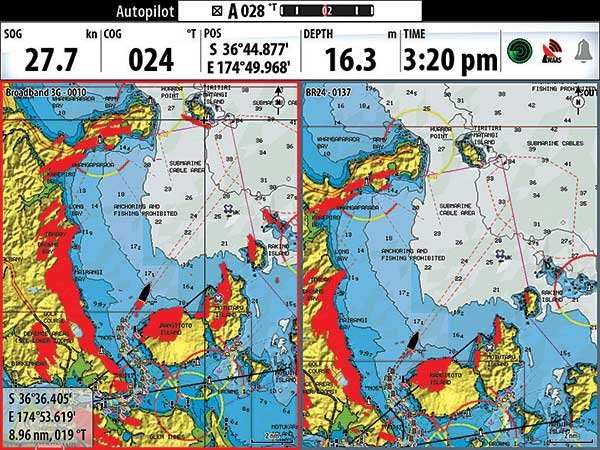We know all you really want to know about your radar is how to look at that LCD screen and distill what’s a channel marker, what’s another boat, and what’s land. If you are investing in a radar system, (one that overlays), your radar returns on your chartplotter screen, its’ probably a good move. (See photo below.) It eliminates an awful lot of the guesswork, as long as the overlay doesn’t add to the confusion. Work with one to see it if works with you.

It’s much easier to tell what you’re seeing on screen when your radar is overlaid on your chartplotter. The red areas show the radar “echo” and clearly delineate the coastal outline.
Zoom In
Beyond that, there are several things to keep in mind. Before you try discriminating between those blips and blobs, zoom in as much as possible. For most of us, the majority of the time what we’re really concerned about lies within a mile or two of our boat. Looking at the radar set to a farther range only reduces the size of the returns you’re concerned about and adds unnecessary information. Long ranges, however, can detect squalls and enable you to cruise around them, can detect landfalls, and have other uses, so don’t just set it for short ranges.
Avoid Split Screen Radar
Don’t view radar on a split screen but instead give it as much LCD territory as possible. The bigger the picture you’re looking at, the easier it will be to figure out what’s what. And when you really need radar, looking at something like the fish-finder should be the least of your concerns, so dedicate that entire screen to what counts. Overlays of information can cause problems or solve them, so as we said before, see what works for you.
Finally, remember that some thoughtful interpretation is often necessary. Three strong returns that remain static and are lined up neatly in a row are likely to be a series of channel markers; weak returns that come and go are often poor targets like small fiberglass boats; and two targets keeping pace close to each other could be a tug and its barge. Accurately reading returns like these requires a different sort of algorithm — the one that’s in your own brain.